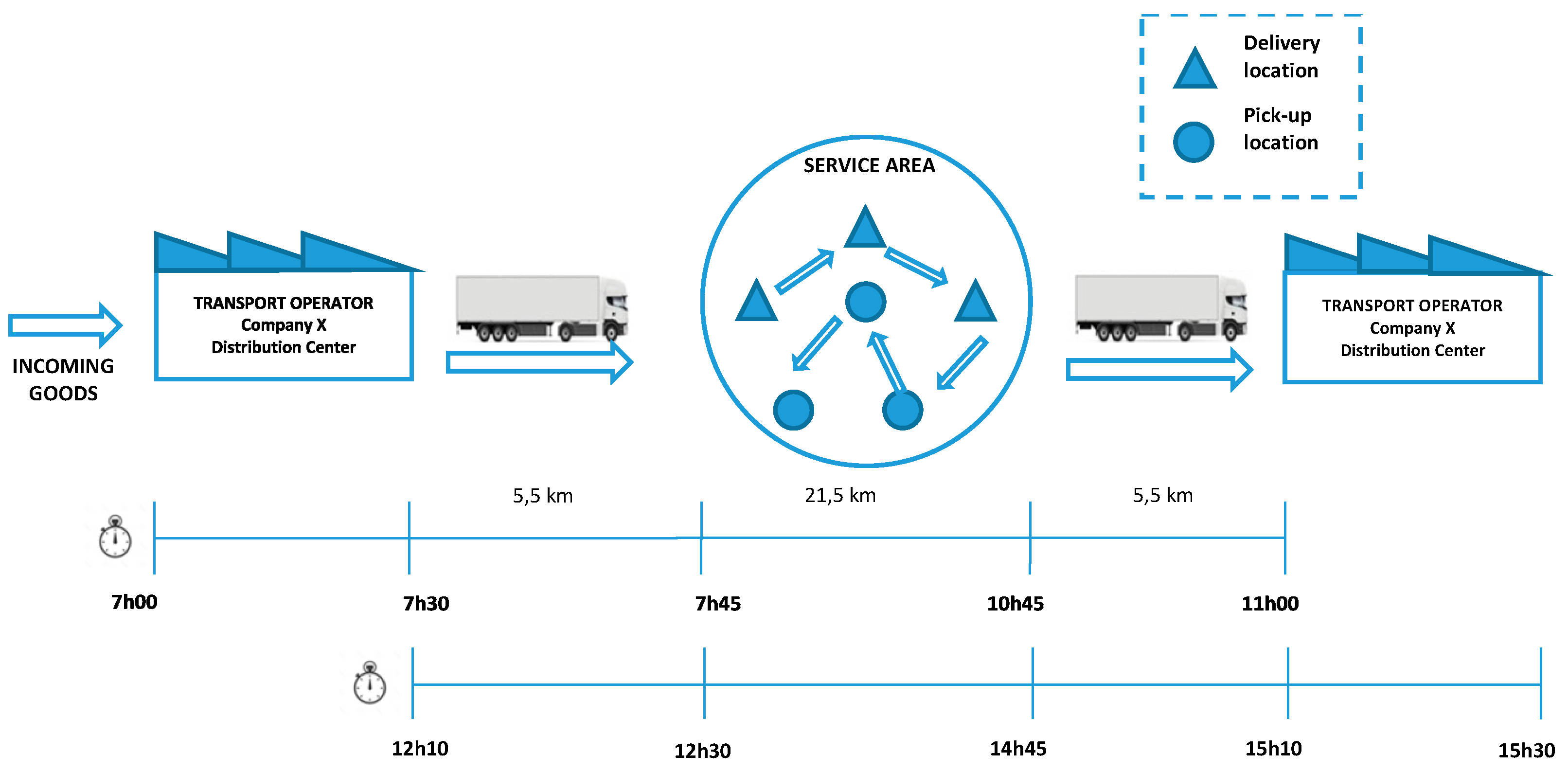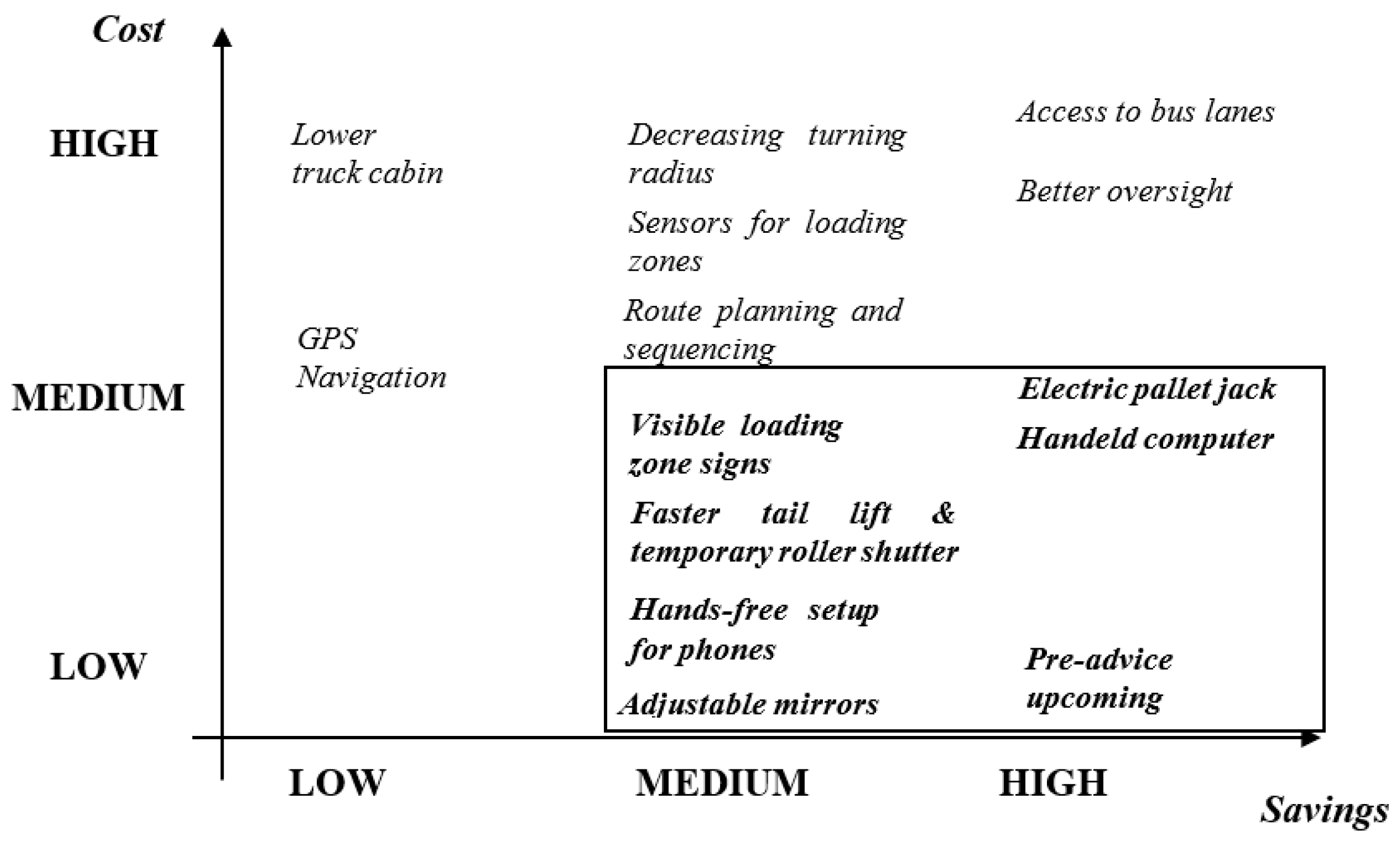A Time-Efficiency Study of Medium-Duty Trucks Delivering in Urban Environments
Abstract
1. Introduction
2. Literature Review
2.1. Transport Efficiency Indicators
2.2. Measures to Improve the Efficiency
2.2.1. Internal Transport Efficiency Measures
2.2.2. Joint Transport Efficiency Measures with the Customers
2.2.3. Joint Transport Efficiency Measures with the Public Sector
3. Case Study
3.1. Case Study Description
3.2. Data Collection
4. Results
4.1. Tour Routes and Speed Data
4.2. Time Study and Activities
5. Discussion
5.1. Overall Insights from Observations and Interviews
5.2. Initiatives
5.2.1. Handling Equipment
5.2.2. Navigation
5.2.3. Regulation and guidelines
6. Conclusions
Author Contributions
Funding
Conflicts of Interest
References
- Ruesca, M.; Petz, C. E-Commerce and Urban Freight Distribution (Home Shopping), in Best Practice Update (Bestufs II), RAPP Trans AG 2008. Available online: http://www.bestufs.net/download/BESTUFS_II/key_issuesII/BESTUFS_II_D2_4_I_E_Commerce_2008.pdf (accessed on 3 November 2019).
- Manzano dos Santos, E.; Sánchez-Díaz, I. Exploring Carriers’ Perception about City Logistics initiatives. Transp. Res. Rec. J. Transp. Res. Board 2016, 2547, 66–73. [Google Scholar] [CrossRef]
- Junior, W.G. A ZMRC e o transporte urbano de cargas na cidade de São Paulo. Rev. Eletrôn. Gest. Serv. 2011, 2, 205–227. [Google Scholar] [CrossRef]
- Alyson, S. Why UPS Is So Efficient: “Our Trucks Never Turn Left”. Available online: https://www.businessinsider.com/ups-efficiency-secret-our-trucks-never-turn-left-2011-3?r=US&IR=T (accessed on 10 September 2017).
- Levandi, A.; Mårdberg, J. Urban Freight Distribution: Assessing Time Efficiency of Daily Activities for Future Development of Medium-Duty Electric Vehicles. Master’s Thesis, Technology Management and Economics, Report No. E2016:045. Chalmers University of Technology, Gothenburg, Sweden, 2018. [Google Scholar]
- De Marco, A.; Mangano, G.; Michelucci, F.V.; Zenezini, G. Using the private finance initiative for energy efficiency projects at the urban scale. Int. J. Energy Sect. Manag. 2016, 10, 99–117. [Google Scholar] [CrossRef]
- Markovits-Somogyi, R. Measuring efficiency in transport: The state of the art of applying data envelopment analysis. Transport 2011, 26, 11–19. [Google Scholar] [CrossRef]
- Arvidsson, N. Essays on Operational Freight Transport Efficiency and Sustainability. Ph.D. Thesis, Gothenburg University, Gothenburg, Sweden, 2013. [Google Scholar]
- Zhang, Z.; Zhang, B. Evaluation about Regional Logistics Efficiency—A Case Study of 31 Regions in Eastern China. In ICLEM 2010: Logistics for Sustained Economic Development: Infrastructure, Information, Integration; ASCE Publications: Chengdu, China, 2010; pp. 843–849. [Google Scholar]
- Arvidsson, N.; Woxenius, J.; Lammgård, C. Review of road hauliers’ measures for increasing transport efficiency and sustainability in urban freight distribution. Transp. Rev. 2013, 33, 107–127. [Google Scholar] [CrossRef]
- Moen, O. The Five-step Model—Procurement to Increase Transport Efficiency for an Urban Distribution of Goods. Transp. Res. Procedia 2016, 12, 861–873. [Google Scholar] [CrossRef][Green Version]
- Markovits-Somogyi, R.; Bokor, Z. Assessing the Logistics Efficiency of European Countries by Using the Dea-Pc Methodology. Transport 2014, 29, 137–145. [Google Scholar] [CrossRef]
- Lu, X.; Xiong, F. An evaluation of urban logistics efficiency in Jiangxi province based on DEA-Malmquist index. In Proceedings of the 2011 International Conference Business Management and Electronic Information (BMEI), Guangzhou, China, 13–15 May 2011; pp. 792–795. [Google Scholar]
- Samuelsson, A.; Tilanus, B. A framework efficiency model for goods transportation, with an application to regional less-than-truckload distribution. Transp. Logist. 1997, 1, 139–151. [Google Scholar] [CrossRef]
- McKinnon, A.C.; Ge, Y. Use of a synchronised vehicle audit to determine opportunities for improving transport efficiency in a supply chain. Int. J. Logist. Res. Appl. 2004, 7, 219–238. [Google Scholar] [CrossRef]
- Santén, V.; Arvidsson, N. Road freight transport efficiency and less environmental impact-the perspectives of transport buyers and operators. In Proceedings of the NOFOMA Conference, Harstad, Norway, 9–10 June 2011. [Google Scholar]
- Santén, V. Exploring Logistics Actions Enabling Environmentally Sustainable Freight Transport. Licentiate Thesis, Technical Report Technology Management and Economics, No. L2013:063. Chalmers University of Technology, Gothenburg, Sweden, 2013. Available online: http://publications.lib.chalmers.se/records/fulltext/172690/172690.pdf (accessed on 6 January 2020).
- Cagliano, A.C.; de Marco, A.; Mustafa, M.S.; Zenezini, G. Analysing the Determinants of Logistics Service Provider Efficiency in Urban Distribution. In Proceedings of the Conference: XIX Summer School, “Francesco Turco” Industrial Mechanical Plants-SSD ING-IND/17, Senigallia, Italy, 9 September 2014. [Google Scholar]
- De Marco, A.; Cagliano, A.C.; Mangano, G.; Perfetti, F. Factor Influencing Logistics Service Providers Efficiency’ in Urban Distribution Systems. Transp. Res. Procedia 2014, 3, 499–507. [Google Scholar] [CrossRef]
- Alises, A.; Vassallo, J.M. Comparison of road freight transport trends in Europe. Coupling and decoupling factors from an Input–Output structural decomposition analysis. Transp. Res. Part A Policy Pract. 2015, 82, 141–157. [Google Scholar] [CrossRef]
- Kot, S. Cost structure in relation to the size of road transport enterprises. Promet Traffic Transp. 2015, 27, 387–394. [Google Scholar] [CrossRef]
- Sternberg, H.; Prockl, G.; Holmström, J. ICT in road transport operations: Analyzing potential effects on individual activity level. In Proceedings of the 23rd NOFOMA Conference 2011, Harstad, Norway, 9–10 June 2011; pp. 1243–1258. [Google Scholar]
- Gonzalez-Calderon, C.; Holguín-Veras, J.; Amaya-Leal, J.; Sánchez-Díaz, I.; Sarmiento-Ordosgoitia, I. Generalized Noortman and Van Es’ Empty Trips Model. 2019; under review. [Google Scholar]
- Santén, V.; Rogerson, S. Influencing load factor in transport operations: A literature review. In Proceedings of the LRN Logistics Research Network conference, Huddersfield, UK, 3–5 September 2014. [Google Scholar]
- Ivanov, B.; Goodchild, A. The Final 50 Feet of the Urban Goods Delivery System. In Proceedings of the Transportation Research Board 97th Annual Meeting, Washington, DC, USA, 7–11 January 2018. [Google Scholar]
- Holguín-Veras, J.; Leal, J.A.; Sánchez-Diaz, I.; Browne, M.; Wojtowicz, J. State of the art and practice of urban freight management: Part I: Infrastructure, vehicle-related, and traffic operations. Transp. Res. Part. A Policy Pract. 2018, in press. [Google Scholar]
- Holguín-Veras, J.; Leal, J.A.; Sanchez-Diaz, I.; Browne, M.; Wojtowicz, J. State of the art and practice of urban freight management Part II: Financial approaches, logistics, and demand management. Transp. Res. Part. A Policy Pract. 2018, in press. [Google Scholar]
- Bell, E.; Bryman, A.; Harley, B. Business Research Methods; Oxford University Press: Oxford, UK, 2018. [Google Scholar]
- Analys, T. Swedish National and International Road Goods Transport, 2016th ed.; Trafikanalys: Stockholm, Sweden, 2017. [Google Scholar]
- Salvendy, G. Stop watch time study and most: Work measurement techniques. In Handbook of Industrial Engineering: Technology and Operations Management; John Wiley & Sons: Hoboken, NJ, USA, 2001. [Google Scholar]
- Allen, J.; Bektas, T.; Cherrett, T.; Bates, O.; Friday, A.; McLeod, F.; Piecyk, M.; Piotrowska, M.; Nguyen, T.; Wise, S. The scope for pavement porters: addressing the challenges of last-mile parcel delivery in London. Transp. Res. Record 2018, 2672, 184–193. [Google Scholar] [CrossRef]



| Activity Location | Activity | Mean | CV (%) | Daily Average | Weekly Share (%) | Weekly Total |
|---|---|---|---|---|---|---|
| Cabin | Driving | 00:07:19 | 87.2 | 02:35:26 | 29.9 | 12:57:11 |
| Park/reverse truck | 00:00:43 | 116.1 | 00:14:58 | 2.9 | 01:14:48 | |
| Administration inside the cabin | 00:00:37 | 148.3 | 00:07:04 | 1.4 | 00:35:19 | |
| Parking spot search | 00:00:31 | 68.7 | 00:01:01 | 0.2 | 00:05:07 | |
| Around vehicle | To customer with goods | 00:00:40 | 110.2 | 00:21:02 | 4 | 01:45:09 |
| Waiting for customer | 00:01:04 | 207.0 | 00:19:01 | 3.7 | 01:35:04 | |
| Walking to/from the cab | 00:00:21 | 115.8 | 00:16:53 | 3.2 | 01:24:23 | |
| From customer without goods | 00:00:28 | 118.2 | 00:13:54 | 2.7 | 01:09:28 | |
| Contact customer | 00:01:45 | 234.7 | 00:10:28 | 2 | 00:52:19 | |
| Signature | 00:00:38 | 67.2 | 00:09:10 | 1.8 | 00:45:52 | |
| To customer without goods | 00:00:28 | 110.9 | 00:09:09 | 1.8 | 00:45:43 | |
| From customer with goods | 00:00:31 | 83.4 | 00:08:28 | 1.6 | 00:42:19 | |
| Scan documents | 00:00:32 | 105.3 | 00:06:23 | 1.2 | 00:31:55 | |
| (Un)loading at the customer site | 00:01:06 | 123.0 | 00:02:35 | 0.5 | 00:12:53 | |
| Break | Break | 00:21:23 | 118.2 | 01:16:01 | 14.6 | 06:20:06 |
| Conversing | 00:00:40 | 103.3 | 00:12:37 | 2.4 | 01:03:06 | |
| Terminal | Route planning | 00:01:15 | 140.2 | 00:20:44 | 4 | 01:43:41 |
| Load goods with pallet jack | 00:01:28 | 107.6 | 00:15:34 | 3 | 01:17:49 | |
| Terminal driving | 00:01:11 | 364.0 | 00:13:07 | 2.5 | 01:05:35 | |
| Load goods w/ electric pallet jack | 00:02:34 | 119.1 | 00:10:51 | 2.1 | 00:54:14 | |
| Unload goods with pallet jack | 00:02:55 | 146.0 | 00:07:48 | 1.5 | 00:38:59 | |
| Unload goods with electric pallet jack | 00:03:00 | 132.7 | 00:05:20 | 1 | 00:26:41 | |
| Close/open the terminal gate | 00:00:25 | 57.8 | 00:03:26 | 0.7 | 00:17:08 | |
| Unloading | Unload truck | 00:00:28 | 83.4 | 00:11:34 | 2.2 | 00:57:51 |
| Tail lift down | 00:00:16 | 53.5 | 00:10:59 | 2.1 | 00:54:53 | |
| Tail lift u | 00:00:14 | 36.9 | 00:08:44 | 1.7 | 00:43:42 | |
| Pallet jack handling | 00:00:16 | 160.6 | 00:07:49 | 1.5 | 00:39:03 | |
| Pick-up/loading | 00:00:24 | 53.4 | 00:06:23 | 1.2 | 00:31:57 | |
| Secure cargo | 00:00:20 | 57.7 | 00:05:08 | 1 | 00:25:42 | |
| Moving other goods | 00:00:21 | 82.3 | 00:04:34 | 0.9 | 00:22:52 | |
| Other | Other | 00:02:47 | 64.5 | 00:04:20 | 0.8 | 00:21:40 |
| Type | Classification | Fulfiller | Initiative |
|---|---|---|---|
| Engineering design | Vehicle | Truck manufacturer | Better oversight and sensors |
| Decreased turning radius | |||
| Adjustable mirrors | |||
| Lower truck cabin | |||
| Hands-free setup for phones | |||
| Faster tail lift and temporary roller shutter | |||
| Operational | Handling equipment | Operator | Handheld computer |
| Electric pallet jack | |||
| Navigation | GPS navigation | ||
| Route planning and sequencing | |||
| Operator and receivers | Pre-advice on upcoming customers | ||
| Traffic engineering | Regulation and guidelines | Public authority | Access to bus lanes |
| Sensors for loading zones | |||
| Public authority and receivers | Visible loading zone signs |
© 2020 by the authors. Licensee MDPI, Basel, Switzerland. This article is an open access article distributed under the terms and conditions of the Creative Commons Attribution (CC BY) license (http://creativecommons.org/licenses/by/4.0/).
Share and Cite
Sanchez-Diaz, I.; Palacios-Argüello, L.; Levandi, A.; Mardberg, J.; Basso, R. A Time-Efficiency Study of Medium-Duty Trucks Delivering in Urban Environments. Sustainability 2020, 12, 425. https://doi.org/10.3390/su12010425
Sanchez-Diaz I, Palacios-Argüello L, Levandi A, Mardberg J, Basso R. A Time-Efficiency Study of Medium-Duty Trucks Delivering in Urban Environments. Sustainability. 2020; 12(1):425. https://doi.org/10.3390/su12010425
Chicago/Turabian StyleSanchez-Diaz, Ivan, Laura Palacios-Argüello, Anders Levandi, Jimmy Mardberg, and Rafael Basso. 2020. "A Time-Efficiency Study of Medium-Duty Trucks Delivering in Urban Environments" Sustainability 12, no. 1: 425. https://doi.org/10.3390/su12010425
APA StyleSanchez-Diaz, I., Palacios-Argüello, L., Levandi, A., Mardberg, J., & Basso, R. (2020). A Time-Efficiency Study of Medium-Duty Trucks Delivering in Urban Environments. Sustainability, 12(1), 425. https://doi.org/10.3390/su12010425




